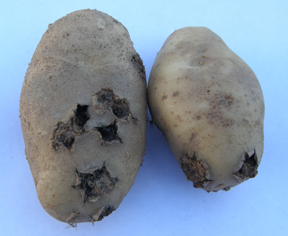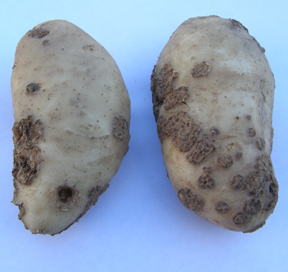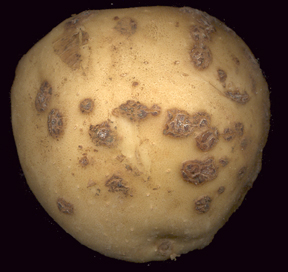Bulletin #2440, Common Scab Disease of Potatoes
Bulletin #2440, Common Scab Disease of Potatoes (PDF)
Extension Crops Specialist Steven B. Johnson and David Lambert, Associate Professor of Plant, Soil, and Environmental Science
For information about UMaine Extension programs and resources, visit extension.umaine.edu.
Find more of our publications and books at extension.umaine.edu/publications/.
History
Common scab of potato, which has a worldwide distribution, is caused by filamentous bacteria in the genus Streptomyces. This genus is diverse and abundant in most soils of the world. The most widely distributed pathogen in the genus is Streptomyces scabies. Streptomyces scabies causes common scab of potato. In addition to Streptomyces scabies, Maine soils may have S. acidiscabies, which tolerates very acidic soils and is usually seed-borne, and S. turgidiscabies, which is also somewhat more tolerant of acidity. Streptomyces acidiscabies is able to cause disease at a lower soil pH than that of Streptomyces scabies. Streptomyces turgidiscabies also may be present and contribute lesions. Potato scab is a production problem that affects grade quality but has only a negligible effect on total yield or storability. Other root crops, including beets, carrots, radishes, and parsnips, are also susceptible to the disease. In general, scab tends to be worse in drier, lighter soils and those high in organic matter.
Life Cycle
Streptomyces scabies is a saprophyte that can survive for long periods on decaying soil organic matter in the absence of hosts. Susceptibility to S. scabies increases from about pH 5.2 to an optimum of between 6.0 and 7.5. The pathogens can tolerate a wide temperature range, but the optimum range for infecting tubers is between 70 and 75°F.
The pathogens enter through wounds, lenticels, or directly through the skin of young developing tubers and stimulate the growth of corky tissue. Lesions expand as the tubers expand. The pathogen produces spores in the lesions.
Tubers are susceptible as soon as they are formed. Dry soil conditions during this period reduce competition and can serve to encourage infection by the pathogens. Scab symptoms are most notable at harvest or later in the season A mature tuber with good skin set is no longer susceptible to new infection by the pathogen.
Increased populations of the pathogens can occur with repeated plantings of susceptible crops. The addition of manure may increase scab severity by providing a substrate for the organism, by increasing soil pH, or by being contaminated from animals fed scabby potatoes. Rotation with nonhosts will reduce but not eliminate the pathogen. Streptomyces spp. can survive in the soil as saprophytes. Infected seed serves to distribute the pathogen. Neither the pathogens nor the disease develops on tubers in storage.
Symptoms
Potato scab lesions on tubers can be quite variable but generally appear as rough, corky lesions, which may range from small and raised to deeply pitted. Initially, infections appear as small tan to reddish-brown spots on the tuber surface. Pitted scab can be as deep as one-half inch into the tuber. Tubers with russetted scab can have large areas superficially covered with corky tissue.
- Tubers with deep-pitted scab symptoms. Photo by Steven B. Johnson.
- Tuber with russetted scab symptoms. Photo by David Lambert.
Infections can also occur on the stems, stolons, or roots. Russetted varieties tend to be less affected than smooth-skinned varieties. Susceptibility varies considerably, but even the most resistant varieties may have significant amounts of disease in some years.
- Tubers with scab symptoms. Photo by Steven B. Johnson.
- Tuber with scab symptoms. Photo by David Lambert.
Control
Chemical controls, short of soil fumigation, are not particularly effective. Planting certified seed with no scab lesions is the most effective means of control. Treatment with mancozeb has been suggested for seed with some scab contamination.
Amend the soil to increase the acidity. Use acidifying fertilizers; use gypsum rather than lime.
Varieties with some resistance to scab include Nooksack, Russet Burbank, Superior, and Dark Red Norland. Several of the fingerling type varieties also have some resistance. Yukon Gold, Kennebec, Katahdin, Norwis, Shepody, Russet Norkotah, and Defender are some of the more scab-susceptible lines.
Reviewed by Extension Crops Specialist James Dwyer
Information in this publication is provided purely for educational purposes. No responsibility is assumed for any problems associated with the use of products or services mentioned. No endorsement of products or companies is intended, nor is criticism of unnamed products or companies implied.
© 2010, 2020
Call 800.287.0274 (in Maine), or 207.581.3188, for information on publications and program offerings from University of Maine Cooperative Extension, or visit extension.umaine.edu.
The University of Maine is an EEO/AA employer, and does not discriminate on the grounds of race, color, religion, sex, sexual orientation, transgender status, gender expression, national origin, citizenship status, age, disability, genetic information or veteran’s status in employment, education, and all other programs and activities. The following person has been designated to handle inquiries regarding non-discrimination policies: Director of Equal Opportunity, 101 North Stevens Hall, University of Maine, Orono, ME 04469-5754, 207.581.1226, TTY 711 (Maine Relay System).





